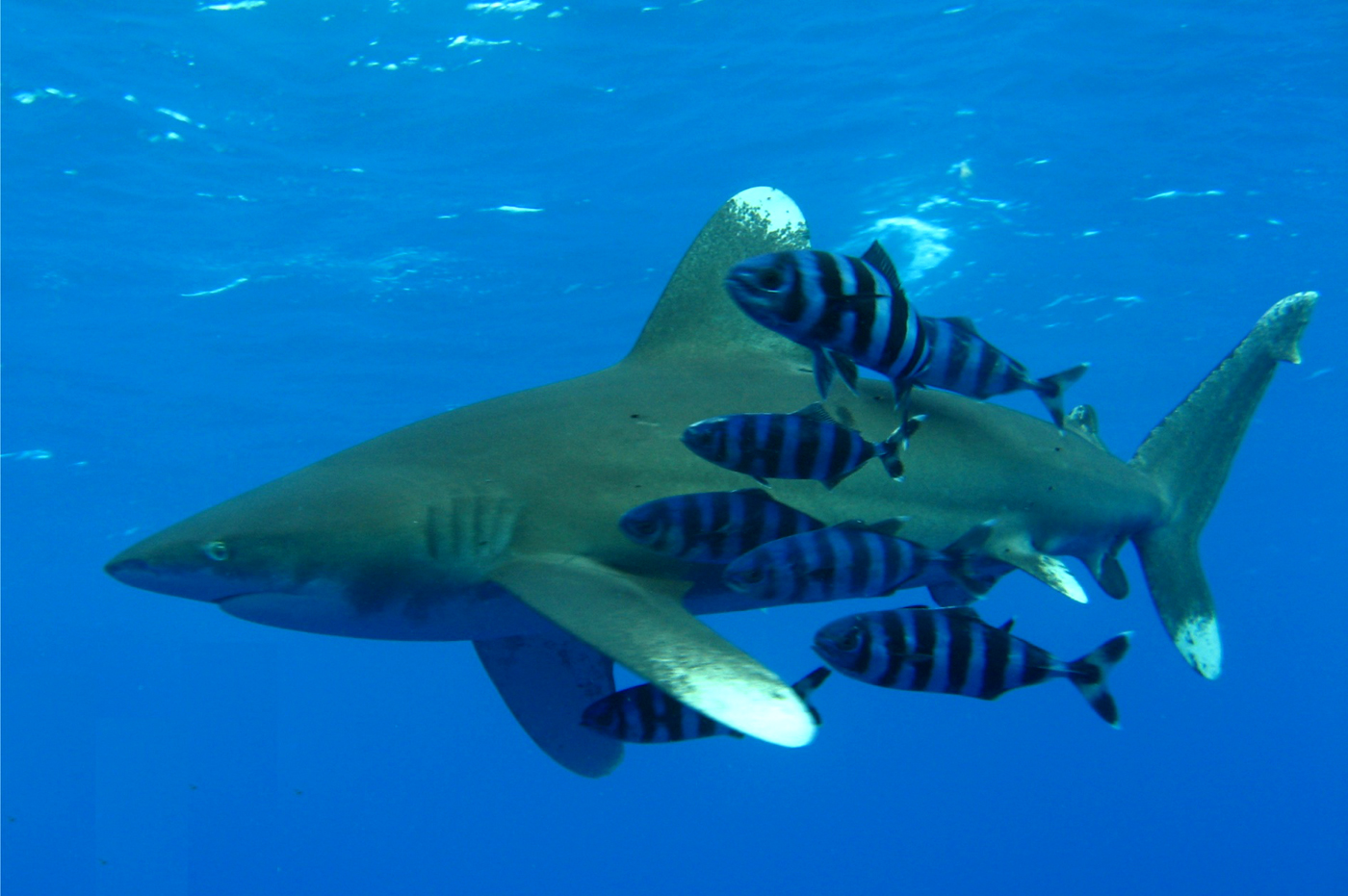Oceanic Whitetip Shark, Carcharhinus longimanus (Poey 1861)

An Oceanic Whitetip Shark, Carcharhinus longimanus, and Pilotfish, Naucrates ductor, at Small Brother Reef, Egypt, Red Sea. Source: Johan Lantz / Wikimedia Commons via EOL. License: CC BY Attribution-Noncommercial-ShareAlike
A bronzy grey shark becoming paler below, with mottled white tips on the first dorsal, anal, pectoral and caudal fins. Juveniles have black or dusky fin tips, and a black saddle on the caudal peduncle. The first dorsal and pectoral fins are very large with broadly rounded tips, and the origin of the first dorsal-fin is closer to origin of the pectoral fins than to the origin of the pelvic fins.
Although rarely encountered, the Oceanic Whitetip Shark is one of the four most dangerous sharks to humans.
Great footage of Oceanic Whitetip Sharks
Video of an Oceanic Whitetip from the ARKive group.
Oceanic Whitetip Shark, Carcharhinus longimanus (Poey 1861)
More Info
|
Distribution |
Widespread in tropical and warm temperate waters (usually in waters above 20 C) of all oceans - usually well offshore beyond the continental shelf between about 30°N and 35°S, or around oceanic islands. The species occurs at depths from the surface to 150 m. Oceanic Whitetip Sharks rarely come close to land. In Australia, the species occurs mostly in oceanic areas off northern Australia (rare or absent in the Arafura Sea and Gulf of Carpentaria); recorded off South Australia but usually rare off the southern coast. |
|
Features |
Vertebrae (precaudal) 123-131; (total) 228-244. Snout short (length to mouth 6-8% TL), rounded; very short upper labial furrows only; upper teeth of adult males broadly triangular, margins coarsely serrate; interdorsal ridge usually present. |
|
Size |
Reaches more than 3 metres in length. |
|
Colour |
Bronzy grey above, paler below; First dorsal, pectoral and caudal fins with mottled white tips (black or dusky tipped in juveniles); black saddles on caudal peduncle in juveniles. |
|
Feeding |
Feeds mostly on a variety of pelagic bony fishes, as well as on squid. Prey also includes crustaceans, stingrays, turtles, sea birds and carrion (dead whales and dolphins). |
|
Biology |
Reproduction is viviparous, meaning that the young are nourished by a placental yolk-sac attached to the wall of the uterus, before being born live. Females give birth to litters of 4-8 young born at 60-65 cm TL after a 10-12 month gestation period. Pups were born from January to March off New South Wales, and very young sharks are found well-offshore. Individuals mature between 4-5 years of age; males mature at 1.75-1.95 m; females mature at 1.8-2.0 m. |
|
Fisheries |
The Oceanic Whitetip Shark is fished throughout most of its range, and overfishes in the western-central Pacific. The species is taken as bycatch in pelagic fisheries throughout its range - mostly by pelagic longlines, and by pelagic gillnets, handlines and occasionally pelagic and even bottom trawls. The species is caught by
Japanese tuna longliners in northern Australia and retained for its large fins which are highly prized in international trade. Oceanic Whitetips are of little or no commercial value in Australia. |
|
Conservation |
IUCN Red List: Near Threatened CITES: Listed on Appendix II Proposal info The Oceanic Whitetip is also listed as a highly migratory species under the 1995 UN Agreement on the Conservation and Management of Straddling Fish Stocks and Highly Migratory Fish Stocks (UNFSA). The Oceanic Whitetip Shark is heavily exploited globally for its large fins which are highly valued in the international shark-fin trade. The species is vulnerable to overfishing as it is late to mature, has a long gestation period and females produce few young. |
|
Species Citation |
Squalus longimanus Poey, 1861, Memorias, 2: 338 pl. 19, figs. 9-10. Type locality: Cuba. |
|
Author |
Bray, D.J. 2017 |
|
Resources |






